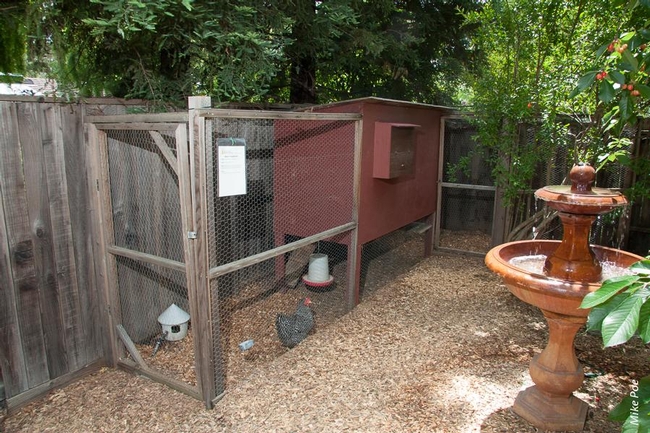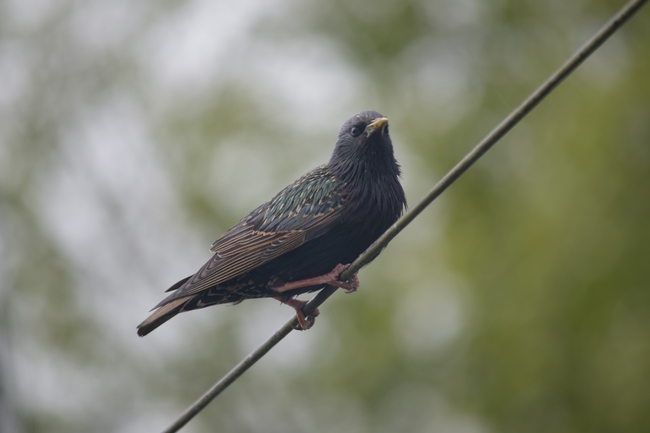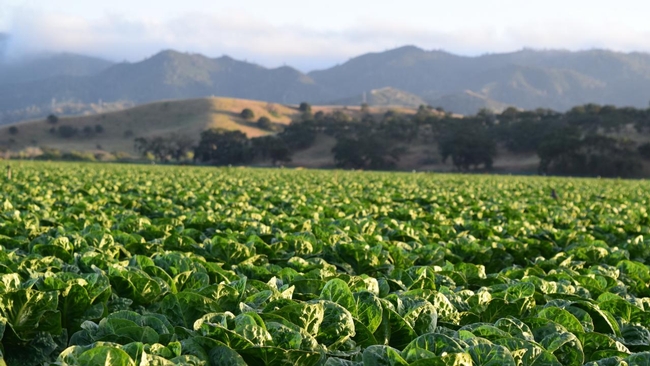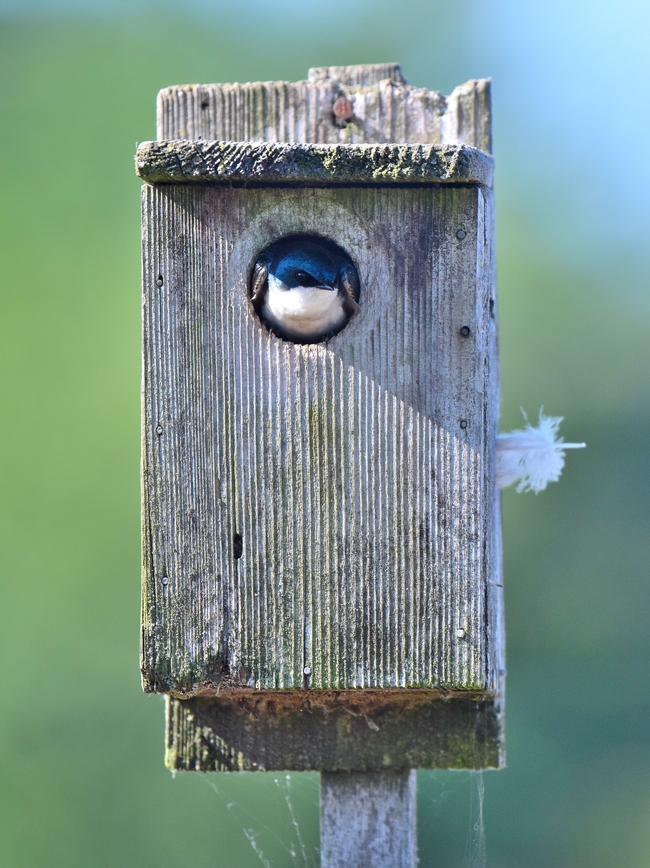
Posts Tagged: salmonella
Researchers pinpoint which bird species pose food safety risk to crops
E. coli and Salmonella are rare in wild birds, Campylobacter more common
Concerns over foodborne risk from birds may not be as severe as once thought by produce farmers, according to research from the University of California, Davis, that found low instances of E. coli and Salmonella prevalence.
While the research found that the risk is often low, it varies depending on species. Birds like starlings that flock in large numbers and forage on the ground near cattle are more likely to spread pathogenic bacteria to crops like lettuce, spinach and broccoli, according to a study of food safety risk and bird pathogens from the University of California Davis. In contrast, insect-eating species were less likely to carry pathogens.
The findings, published in the journal Ecological Applications, suggest that current practice of removing bird habitats around produce growers' farms over concerns the animals could bring foodborne pathogens into their fields may not solve the problem.
“Farmers are increasingly concerned that birds may be spreading foodborne diseases to their crops,” said Daniel Karp, the senior author on the study and an assistant professor in the UC Davis Department of Wildlife, Fish and Conservation Biology. “Yet not all bird species are equally risky.”
Only one foodborne disease outbreak in produce has been conclusively traced to birds: a Campylobacter outbreak in peas from Alaska. While the bacteria can cause diarrhea and other foodborne illness in humans, it's less of a concern to growers than E. coli and Salmonella, which have been responsible for multiple outbreaks across the nation.
In this study, researchers compiled more than 11,000 bacteria tests of wild bird feces and found that Campylobacter was detected in 8 percent of samples. But pathogenic E. Coli and Salmonella were only found in very rare cases (less than 0.5%).
In addition to the bacteria tests, researchers conducted roughly 1,500 bird surveys across 350 fresh produce fields in Western states and collected more than 1,200 fecal samples from fields. They then modeled the prevalence of pathogens in feces, interactions with crops, and the likelihood of different bird species to defecate on crops to determine risk.
Insect-eating birds pose lower risk
Based on the data, insect-eating birds, such as swallows, present a lower risk, while birds that flock near livestock, such as blackbirds and starlings, are more likely to transmit pathogens.
The data can help the agricultural industry determine risk and take action, such as separating produce crops from cattle lands. They also don't need to treat all birds the same.
“Maybe farmers don't need to be quite as concerned about all types of birds,” Karp said. “Our data suggest that some of the pest-eating birds that can really benefit crop production may not be so risky from a food-safety perspective.”
Removing habitat can backfire
This study and the authors' prior work indicate that removing habitat around farms may actually benefit the species that pose more risk and harm the beneficial, pest-eating ones that are less risky to food safety. This is because many prolific insect-eaters may visit crop fields to eat pests but need nearby natural habitats to survive. In contrast, many of the bird species that most commonly carry foodborne pathogens readily thrive on both cattle farms and produce farms without natural habitat nearby.
Other findings
Insect-eating birds that forage in the tree canopy pose minimal threat because they are less likely to carry foodborne pathogens and come into direct contact with produce. They can also be valuable parts of the ecosystem, particularly if they eat pests that can harm crops. Installing bird boxes could attract the pest-eaters, as well as help with conservation efforts.
“We basically didn't know which birds were problematic,” said lead author Olivia Smith, a postdoctoral researcher at Michigan State University who was at University of Georgia when the paper was written. “I think this is a good step forward for the field.”
Additional co-authoring institutions include James Cook University, UC Berkeley, UC Riverside, University of Kentucky, University of Texas, Virginia Polytechnic Institute and State University, Washington State University, BioEpAr, The Nature Conservancy and Van Andel Institute.
The research was funded by the United States Department of Agriculture and the National Science Foundation.
Salmonella infections resulting from backyard chickens
The Centers for Disease Control and Prevention is investigating a surge in human Salmonella infections linked to contact with live backyard poultry, reported Macy Jenkins on CBS Sacramento News.
The story included interviews with several chicken owners. One small girl said she loves to cuddle her chickens because "They're so cute." The owner of three specialty chickens said he allows the animals to "sleep inside with me in my bed." Both of those practices run counter to guidelines set by the CDC.
Jenkins spoke to UC Cooperative Extension specialist Maurice Pitesky, who said poultry owners should never let the birds inside of the house. His reason: "Always assume that any bird is a Salmonella carrier."
To prevent Salmonella infection, the CDC recommends:
- Always wash hands thoroughly with soap and water right after touching live poultry and anything in the area where the live and roam.
- Never allow poultry in the house, especially not in bathrooms and kitchen.
- Do not snuggle or kiss the birds.
- Stay outdoors when cleaning poultry equipment, such as cages, feed or water containers.
The most common symptoms of Salmonella infection are diarrhea, fever and abdominal cramps. The illness usually last 4 to 7 days, and most people recover without treatment.

As of May 25, 2017, the CDC reports 21 people in California have been infected by Salmonella via backyard chickens.
When salmonella outbreak hit, consumers responded

According to a study conducted by Chantal Toledo and Sofia Berto Villas-Boas in an ARE Update published by UC Davis' Giannini Foundation of Agricultural Economics, consumers tend to respond to food scares and government warnings. This is consistent with a Sacramento Bee report announcing a 25 percent decrease in the sale of Foster Farms chicken. The study also suggests that, in the case of an outbreak, consumers don't always switch to alternative brands. The 2010 egg recall resulted in an overall drop in egg sales because consumers did not switch to alternative egg brands. Although it is too early to determine a change in overall chicken sales, Julia Thomas at the Sacramento Natural Foods Coop has reported a 10 percent increase in chicken sales since the salmonella outbreak. According to Thomas, foodborne disease outbreaks are good for the organic food movement.
The UC Davis School of Veterinary Medicine is planning a series of experiments to better understand Salmonella Heidelberg, the strain of salmonella found in Foster Farms Chicken, which has been a problem for the poultry industry in California and has been associated with human outbreaks since last year. Using molecular techniques, the experiments will study gene expression and determine a better characterization of the strains involved in the outbreak.
The School of Veterinary Medicine is also collaborating with the Animal Science Department at UC Davis and UC Cooperative Extension to leverage DNA sequencing in order to better understand the virulence of Salmonella Heidelberg and it's potential to cause disease under processing conditions.
Concerned about your own chickens? "The CAHFS Lab System routinely provides diagnostic support for commercial, small flock and backyard poultry producers in California," says Richard Breitmeyer, director of the the California Animal Health and Food Safety (CAHFS) Lab System at the UC Davis School of Veterinary Medicine, "including testing for salmonella." More information can be found on their website.
Foodborne Disease Outbreaks and Consumer Purchases

Roasted chicken. (Photo: Wikimedia Commons)
What's in your compost?

Michele Jay-Russell, a veterinarian and research microbiologist at the Western Institute for Food Safety and Security (WIFSS) and program manager of the Western Center for Food Safety (WCFS), recently co-authored a study that highlights the need to be aware of the hazards associated with using raw animal manure to fertilize home gardens. (Read full article here.)
The basis for the study began in July of 2010 when a shire mare from a rural Northern California farm was brought to the William R. Pritchard Veterinary Medical Teaching Hospital for treatment of colic. Following protocol, the veterinarians on call screened the horse for Salmonella to avoid infecting other horses during hospitalization. She tested positive and after successful treatment for colic, went home. Her owners then notified the veterinarians that some of their other draft horses were sick as well — all 8 were tested and 6 came back positive for the same Salmonella Oranienburg strain, including the mare that still had the infection.
Jay-Russell heard about the case from her colleague John Madigan, professor of medicine and epidemiology at the school. The farm’s owners invited Jay-Russell and Madigan to the farm to see if they could uncover the source of the Salmonella infection. They sampled water from horse troughs, manure storage piles, wild turkey feces and soil from the family’s edible home garden where raw horse manure had been used as fertilizer. Each of those locations had a percentage of positive samples over the sampling period from August 2010 to March 2011.
“We showed the owners how to continue collecting samples and provided them with a FedEx number to ship them to UC Davis,” Jay-Russell said. “During that whole time, the garden soil kept coming back positive, which showed that this strain of Salmonella could persist for months.”
While the researchers couldn’t be completely certain about the original source of Salmonella on the farm, they suspect that a recent surge in the wild turkey population on the property introduced the bacteria to the horses by pooping in the horse corrals and in the water troughs. They speculated that the wild turkeys brought the Salmonella onto the property, although they couldn’t rule out the possibility that the birds were exposed on the farm or to other potential sources of Salmonella.
“What is clearer is that the raw horse manure applied as fertilizer was the most likely source of garden soil contamination,” Jay-Russell explained. “We suspect that the damp climate in Mendocino County may have contributed to the longevity of this bacterium in the soil long after the owners stopped applying the horse manure to the garden. Fortunately, the owners didn’t get sick, but our investigation showed the potential for widespread dissemination of Salmonella in a farm environment following equine infection.”
To promote safe gardening practices, Jay-Russell has teamed with Trevor Suslow, a Cooperative Extension food safety specialist in the Department of Plant Sciences, to speak to groups of small farmers around the state about best practices. They also use a brochure in English and Spanish, “Food Safety Tips for Your Edible Home Garden,” that includes information about safe uses of animal manure and ways to minimize animal fecal contamination.
“It’s good to let people know about the risks and to correct misinformation about ways to treat the compost pile before using it in the garden,” Jay-Russell said. “The biggest take home message from this experience is to be very careful about using manure from sick horses — and to be cautious about offers of free manure — you don’t know what’s in there. Commercial compost should be bought from a reputable source.”
She urges gardeners to take a class and learn how to compost correctly and safely. Each county in California has UC Cooperative Extension advisors and many have Master Gardener programs offering information on food safety.
Additional resources:
Foodborne illnesses and the 100K Genome Project

Bart Weimer, professor in the UC Davis School of Veterinary Medicine, serves as director of the 100K Genome Project and co-director of the recently established BGI@UC Davis facility, where the sequencing will be done. Other collaborators include the U.S. Centers for Disease Control and Prevention and the U.S. Department of Agriculture.
The new five-year microbial pathogen project focuses on making the food supply safer for consumers. The group will build a free, public database including sequence information for each pathogen's genome — the complete collection of its hereditary information. The database will contain the genomes of important foodborne pathogens including Salmonella, Listeria, and E. coli, as well as the most common foodborne and waterborne viruses that sicken people and animals.
The project will provide a roadmap for developing tests to identify pathogens and help trace their origins more quickly. The new genome database also will enable scientists to make discoveries that can be used to develop new methods for controlling disease-causing bacteria in the food chain.
"This landmark project will revolutionize our basic understanding of these disease-causing microorganisms," said Harris Lewin, vice chancellor for research at UC Davis.
The sequencing project is critically important for tackling the continuing outbreaks of often-deadly foodborne diseases around the world. In the United States alone, foodborne diseases annually sicken 48 million people and kill 3,000, according to the CDC.
"The lack of information about food-related bacterial genomes is hindering the research community's ability to improve the safety and security of the world food supply," Weimer said. "The data provided by the 100K Genome Project will make diagnostic tests quicker, more reliable, more accurate and more cost-effective."
"We see this project as a way to improve quality of life for a great many people, while minimizing a major business risk for food producers and distributors," said Mike McMullen, president of Agilent’s Chemical Analysis Group.
A consumer-focused article about the project is available on the FDA website.
(This article was condensed from a UC Davis news release. Read the full press release and watch a video of Bart Weimer giving an overview of the project.)



